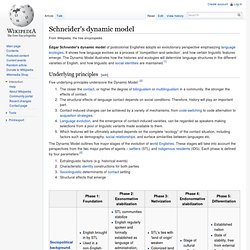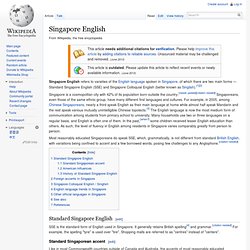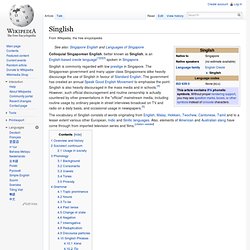

Schneider's Dynamic Model. Edgar Schneider's dynamic model of postcolonial Englishes adopts an evolutionary perspective emphasizing language ecologies.

It shows how language evolves as a process of 'competition-and-selection', and how certain linguistic features emerge. The Dynamic Model illustrates how the histories and ecologies will determine language structures in the different varieties of English, and how linguistic and social identities are maintained.[1] Underlying principles[edit] Five underlying principles underscore the Dynamic Model: [2] The closer the contact, or higher the degree of bilingualism or multilingualism in a community, the stronger the effects of contact.The structural effects of language contact depends on social conditions.
The Dynamic Model outlines five major stages of the evolution of world Englishes. Extralinguistic factors (e.g. historical events)Characteristic identity constructions for both partiesSociolinguistic determinants of contact settingStructural effects that emerge. About Singapore - Singapore culture & language, religion of Singapore, Singlish. Singapore Culture Singapore is a cosmopolitan society where people live harmoniously and interaction among different races are commonly seen. The pattern of Singapore stems from the inherent cultural diversity of the island. The immigrants of the past have given the place a mixture of Malay, Chinese, Indian, and European influences, all of which have intermingled. Behind the facade of a modern city, these ethnic races are still evident.
The areas for the different races, which were designated to them by Sir Stamford Raffles, still remain although the bulk of Singaporeans do think of themselves as Singaporeans, regardless of race or culture. The old streets of Chinatown can still be seen; the Muslim characteristics are still conspicuous in Arab Street; and Little India along Serangoon Road still has its distinct ambience. Each racial group has its own distinctive religion and there are colorful festivals of special significance all year round. Singapore English. Singapore English refers to varieties of the English language spoken in Singapore, of which there are two main forms — Standard Singapore English (SSE) and Singapore Colloquial English (better known as Singlish).[1][2] Singapore is a cosmopolitan city with 42% of its population born outside the country.

[needs update][citation needed] Singaporeans, even those of the same ethnic group, have many different first languages and cultures. For example, in 2005, among Chinese Singaporeans, nearly a third speak English as their main language at home while almost half speak Mandarin and the rest speak various mutually unintelligible Chinese topolects.[3] The English language is now the most medium form of communication among students from primary school to university.
Many households use two or three languages on a regular basis, and English is often one of them. In the past,[when?] Standard Singapore English[edit] SSE is the standard form of English used in Singapore. American influences[edit] Singlish. Colloquial Singaporean English, better known as Singlish, is an English-based creole language[1][2][3] spoken in Singapore.

The vocabulary of Singlish consists of words originating from English, Malay, Hokkien, Teochew, Cantonese, Tamil and to a lesser extent various other European, Indic and Sinitic languages. Also, elements of American and Australian slang have come through from imported television series and films. [citation needed] Overview and history[edit] Singapore English derives its roots from 146 years (1819–1965) of British colonial rule over Singapore. Singlish originated with the arrival of the British and the establishment of English language schools in Singapore.[6] Soon, English filtered out of schools and onto the streets, to be picked up by non-English-speakers in a pidgin-like form for communication purposes.
Thus, in Malaysia, even the Chinese would revert to Malay when speaking to Chinese who did not speak the same Chinese varieties. Sociolect continuum[edit] Singlish. Gateway to World Englishes. Reviews Books Literature on Singapore English Deterding, David (ed.)

Date? English in Singapore: phonetic research on a corpus. Unfortunately, this book is not yet available at the Library of Münster University. [We have ordered the book and hope that it is available in our library soon. Foley, Joseph A. New Englishes: the case of Singapore consists of nine papers written by eight different experts of the topic. [no signature] Gupta, Anthea Fraser (2003). In her article Singlish on the Web, Anthea Fraser Gupta explores in which contexts Singapore English (henceforth Singlish) is used on the Internet. [We have ordered the book and hope that it is available in our library soon. Lim, Lisa (2007). In her article Mergers and acquisitions: on the ages and origins of Singapore English particles, Lisa Lim chooses a new approach to analyse discourse particles in colloquial Singapore English.
[This journal is accessible via the Elektronische Zeitschriftenbibliothekat the RUB]. Platt, John T. (1975).